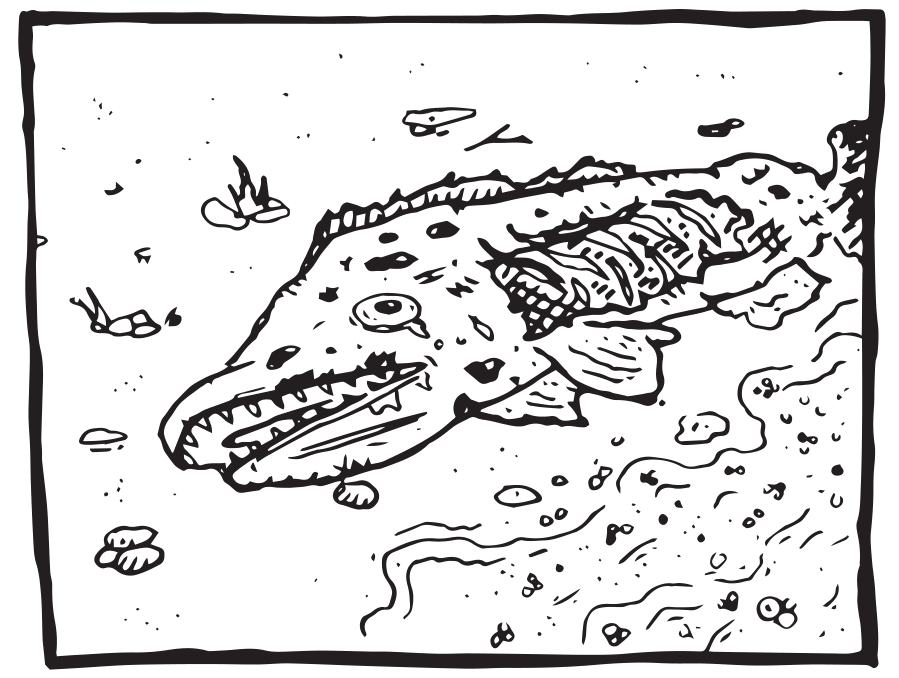My chest waders are on the shelf, where I left them last year. My river rod is on a rack with my other rods, where I left it last year. This fall, I intended to enjoy afternoons on Chilliwack or Vedder River. I didn’t because there weren’t any damn fish.
The life cycle of salmon in brief: Salmon hatch, migrate, live, spawn, then die. They’re anadromous, meaning they’re born in freshwater but live in the salty sea, then return to freshwater to spawn. Here, the salmon will swim up the Fraser then into one of its tributaries. The ladies lay their eggs, and the men fertilize them. The alevins, little fish with yoke sacks for necks hatch, they consume their yoke, then turn into fry.
At the end of summer, the first salmon to arrive at the Fraser estuary are the red Chinook, and shortly after, one of the different Sockeye runs join them. Every second year, Pink runs overlap the Sockeye. Progressing into the fall, as the early runs slow, the white Chinook, Chum, and Coho make their way up the rivers too.
Different salmon species migrate back to the ocean at different rates, but eventually they’ll head to the Pacific. Again, the various species will spend a different amount of time in the ocean before returning to the streams to spawn. Miraculously, they return to the stream in which they were born. Once home, the females build nests, males fight for spawning rights. Then it all repeats.
But for some reason, the cycle isn’t cycling.
In August, the Vancouver Sun reported that Sockeye salmon stocks were down, less than a third of what was expected.
In November, the they reported that Pink salmon returned with drastically fewer than expected numbers.
Also in November, CBC News reported that the Steelhead run numbers show the fish nears the brink of extinction. (As a side note, there’s debate whether Steelhead are trout or salmon.) “According to the data, only 45 steelhead are expected to reach spawning grounds in the Chilcotin watershed this year, and only 145 in the Thompson watershed,” the CBC reported.
“It’s clear that we have a severe conservation crisis on our hands,” said Aaron Hill, executive director of the Watershed Watch Salmon Society.
For decades, scientists, locals, First Nations, fishermen, and the media have asked, “Where have the salmon gone?” And yet the salmon’s plight continues.
In August, thousands of Atlantic salmon escaped from a fish farm east of Victoria after nets containing an estimated 305,000 fish were damaged by “exceptionally high tides and currents.” Too bad these nets in the ocean weren’t built to withstand high tides and currents. A big concern with all of this is that the Atlantic species will become invasive.
Some Indigenous groups and people have demanded that fish farms on their traditional territory be shut down. (Only reconciliation when it’s convenient, am I right?) Their protests, instead, have continually been shut down by the province.
Another concern, clearly voiced in an ongoing series by the Tyee, is the Department of Fisheries and Oceans’ (DFO) attempt to avoid acknowledging the Heart and Skeletal Muscle Inflammation (HSMI), first observed in 2002.
“When DFO has simultaneous mandates to conserve wild stocks and promote the salmon farming industry, there are circumstances in which it can find itself in a conflict of interest because of divided loyalties,” Justice Bruce Cohen said, according to the Tyee article, “Inside DFO’s Battle to Downplay a Deadly Farmed Salmon Disease.”
The Tyee article goes on to say that the researcher and senior fish pathologist at the B.C. government’s Animal Health Centre in Abbotsford and his team, who are responsible for the quarterly audits of the health of B.C.-farmed salmon, strongly denied the presence of the disease.
“The Animal Health Centre receives $7 million in funding from the province’s agriculture ministry and about $1.4 million from clients — including $176,000 from three salmon aquaculture companies in the latest fiscal year. It’s also under contract with the DFO to perform farmed salmon audits,” the article explains.
Salmon are as symbolic of the Fraser Valley as the Fraser itself. It’d be a shame if the species dwindled out of existence. Every organization truly rooted, truly within the Fraser Valley (especially those branded as such) should be concerned — then shortly after must ask, “What can we do?”
UFV’s S’eliyemetaxwtexw Art Gallery currently features a sculture exhibit entitled Deep Sea Changes. As the article on page 13 notes, the work of art takes an active stance against ocean pollution. It’s a beautiful exhibit, worth visiting, worth pondering.
 Image: Caleb Campbell/The Cascade
Image: Caleb Campbell/The Cascade


